Understanding the Pathobiology of Chemotherapy-Induced Nausea and Vomiting
Improved understanding of the physiologic and neuropharmacologicmechanisms underlying chemotherapy-induced nausea andvomiting (CINV) has driven significant progress in the treatment ofCINV over the past 2 decades. Recognition of the role of neurotransmittersand their receptors in the process of CINV has been central tothis progress. Initial attention focused on dopamine, then on serotonin,and most recently on substance P, which has yielded a usefulnew class of antiemetic medications known as selective neurokinin-1receptor antagonists. Preclinical studies of these neurokinin-1 receptorantagonists suggested that they would demonstrate broad antiemeticactivity in acute emesis, demonstrate activity against cisplatininduceddelayed emesis, be well tolerated, and contribute to enhancedefficacy when used in combination with other classes of antiemetics.These suggestions appear to have been largely borne out in clinicaltrials. Pharmacogenomics may offer a means to further extend andapply our understanding of CINV by enabling more selective targetingof antiemetic therapies. To date, the application of pharmacogenomicsto CINV has focused on variations in the metabolism of serotoninreceptor antagonists by CYP 450 genotype and variations in the5-HT3 receptor gene itself.
ABSTRACT: Improved understanding of the physiologic and neuropharmacologicmechanisms underlying chemotherapy-induced nausea andvomiting (CINV) has driven significant progress in the treatment ofCINV over the past 2 decades. Recognition of the role of neurotransmittersand their receptors in the process of CINV has been central tothis progress. Initial attention focused on dopamine, then on serotonin,and most recently on substance P, which has yielded a usefulnew class of antiemetic medications known as selective neurokinin-1receptor antagonists. Preclinical studies of these neurokinin-1 receptorantagonists suggested that they would demonstrate broad antiemeticactivity in acute emesis, demonstrate activity against cisplatininduceddelayed emesis, be well tolerated, and contribute to enhancedefficacy when used in combination with other classes of antiemetics.These suggestions appear to have been largely borne out in clinicaltrials. Pharmacogenomics may offer a means to further extend andapply our understanding of CINV by enabling more selective targetingof antiemetic therapies. To date, the application of pharmacogenomicsto CINV has focused on variations in the metabolism of serotoninreceptor antagonists by CYP 450 genotype and variations in the5-HT3 receptor gene itself.
For patients with cancer, nausea and vomiting have been among the most feared side effects of antineoplastic therapy. The past 20 years have witnessed important progress in developing new options for preventing chemotherapy-induced nausea and vomiting (CINV) in these patients. A central driver of this progress has been an improved understanding of the basic physiologic and neuropharmacologic mechanisms underlying the CINV process. This article will highlight key insights into the pathobiology of CINV that have emerged during this period, particularly regarding the neurotransmitter that has been the focus of interest most recently-substance P. The article concludes with a brief look ahead to a promising means for achieving further progress in this area-the application of pharmacogenomics to CINV therapy.
The Physiology of Emesis
The emetic reflex has evolved over the eons and across many different species. It most likely evolved as a defensive mechanism that provides organisms with a means to expel potentially toxic ingested substances. Because emesis has developed over so long a time, it likely will be very difficult to extinguish, given the considerable redundancy in the reflex pathways involved in the emetic process. Our current understanding of the structures and neural circuitry involved in the emetic reflex has evolved from the pioneering studies of Borison and Wang in the 1940s and 1950s.[1] They first introduced the concept ofan "emetic center" or "vomiting center" in the brainstem that receives afferent input from a host of sites, such as the gastrointestinal tract, intracranial pressure receptors in the brain, the cortical system, the vestibular labyrinths, and the "chemoreceptor trigger zone" (area postrema). The emetic center is not an anatomically distinct area but rather a variety of areas that work collectively to serve as the final common pathway to activate the salivatory center, the vasomotor center, the respiratory center, and the cranial nerves. Together these areas provide the final efferent output to the abdominal muscles, the diaphragm, the stomach, and the esophagus that results in the emetic reflex itself.[1,2]
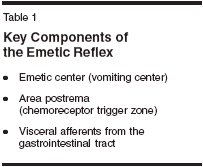
The emetic reflex has three key components, as outlined in Table 1 and illustrated in Figure 1. The first component is the emetic center, which was discussed above. The second component is the area postrema, located inthe medulla in the floor of the fourth ventricle. It is accessible both to the cerebrospinal fluid and, since it is outside the blood-brain barrier, to bloodborne toxins. Its alternate name-the chemoreceptor trigger zone-stems from its potential to be impacted by materials in either the cerebrospinal fluid or the blood. The third component of the emetic reflex is the visceral afferent nerve fibers that come from the small intestine. These vagal and splanchnic afferents project either directly up to the emetic center or indirectly via the area postrema. Insights into the anatomic location of these key components of the emetic reflex arc have been accompanied by an increasing recognition of the role played by a multitude of neuroactive substances (Figure 2) and their receptors in these processes. Initial attention focused on dopamine, given the modest to moderate clinical efficacy of antidopaminergic agents on CINV and the recognition that apomorphine, a dopamine type 2 (D2) receptor agonist, can evoke emesis bybinding to D2 receptors in the area postrema.
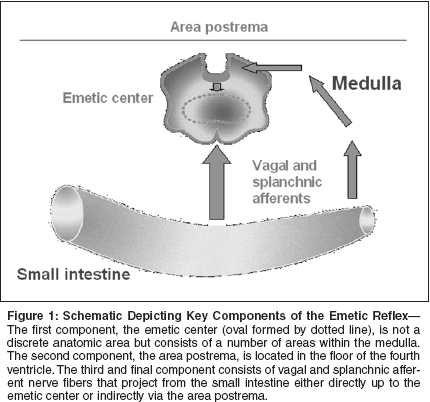
Beginning in the mid-1980s, the focus of attention shifted to serotonin. The demonstration by Miner and Sanger in 1986 that a selective antagonist of the 5-hydroxytryptamine type 3 (5-HT3) receptor could abolish cisplatin- induced emesis in the ferret[3] ushered in a productive period of basic and clinical research that resulted in the regulatory approval of a number of selective 5-HT3 (serotonin) receptor antagonists that now form the cornerstone of antiemetic therapy for CINV. However, despite the clear-cut therapeutic advance represented by the 5-HT3 receptor antagonists, it was soon evident that these agents were not completely effective in controlling emesis. Some patients continued to experience nausea and vomiting in the first 24 hours after chemotherapy. More problematic was the apparent lack of efficacy of these agents in preventing emesis more than 24 hours after chemotherapy (delayed emesis). There clearly remained a strong rationale to search for other relevant neurotransmitters, and over the past decade substance P has become a focus of intense interest.
Substance P
Substance P is an 11-amino-acid regulatory peptide, one of three tachykinins identified to date (the others are neurokinin A and neurokinin B). The tachykinins bind to various neurokinin (NK) receptors, of which at least three subtypes have been isolated: NK-1, NK-2, and NK-3/3B. Substance P is the preferred ligand for NK-1 receptors, which are found in substantial numbers in key areas of the emetic reflex arc, such as the gastrointestinal tract, the area postrema, and the nucleus tractus solitarius. Substance P excites cholinergic neurons, causes vasodilatation, stimulates salivatory secretion, and contracts smooth muscle. While this clearly has implications for emesis, it also has potential implications for other pathologic processes, such as depression, asthma, bladder irritability, inflammatory bowel disease, and other functionalgastrointestinal diseases.[4] The initial recognition that substance P might have a role in emesis dates back 20 years (Table 2) to when Carpenter and colleagues showed that giving substance P to dogs could evoke emesis.[5] About a decade later, Andrews and Bhandari suggested that resinferatoxin may exert its potent antiemetic effect by depleting substance P at a central site in the emetic reflex arc in the ferret.[6] At about the same time, a number of scientists succeeded in developing selective NK-1 receptor antagonists and demonstrated that they exert broad antiemetic effects in the ferret.[7,8] Together these early studies strongly suggested that substance P may have relevance to emesis in humans.
Lessons From Preclinical Studies of NK-1 Antagonists
Subsequent preclinical studies revealed three important principles about the use of selective NK-1 receptor antagonists to combat emesis: (1) they have a broad spectrum of antiemetic action; (2) their effect is primarily a central one, exerted via the central nervous system (CNS); and (3) they are effective against both acute and delayed emesis.
Spectrum of Antiemetic Action
Unlike previous antiemetic medications, NK-1 receptor antagonists are effective against a variety of emetic stimuli that work via different mechanisms of action. This was demonstrated in a ferret model reported by Watson and colleagues using the early NK-1 receptor antagonist CP-99,994 against a variety of emetic stimuli-copper sulfate, loperamide, cisplatin, ipecac, and apomorphine.[ 9] In response to each of these stimuli, the animals treated with the NK-1 receptor antagonist experienced significantly fewer retching and vomiting episodes than did untreated animals.
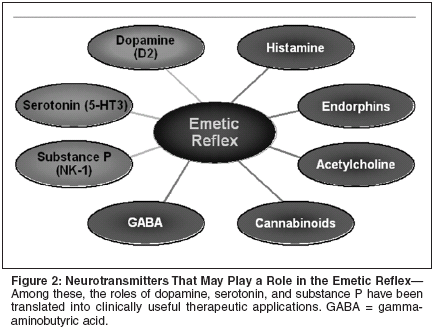
These findings were confirmed in a study by Hale and colleagues using another NK-1 receptor antagonist, MK-869, which is now known as the drug aprepitant (Emend), in ferrets that were given either cisplatin, apomorphine, or morphine as the emetic stimulus.[10] As shown in Figure 3, there was again a marked reduction in retching and vomiting episodes when the animals were pretreated with the NK-1 receptor antagonist. Again, all three of the emetic stimuli used act by different mechanisms.
Site of Antiemetic Action
Whereas serotonin receptor antagonists exert their antiemetic effect primarily in the gut, by antagonizing serotonin binding to 5-HT3 receptors in the small intestine, the NK-1 receptor antagonists seem to primarily exert their effect centrally, so that it is critical that they get into the CNS. This was demonstrated by Tattersall and colleagues in another ferret study[11]; this one used two equally potent NK- 1 receptor antagonists-L-741,671 and L-743,310-whose only difference is that the former penetrates the brain but the latter does not, owing to its quaternary structure. When tested against cisplatin-induced emesis in theWhereas serotonin receptor antagonists exert their antiemetic effect primarily in the gut, by antagonizing serotonin binding to 5-HT3 receptors in the small intestine, the NK-1 receptor antagonists seem to primarily exert their effect centrally, so that it is critical that they get into the CNS. This was demonstrated by Tattersall and colleagues in another ferret study[11]; this one used two equally potent NK- 1 receptor antagonists-L-741,671 and L743,310-whose only difference is that the former penetrates the brain but the latter does not, owing to its quaternary structure. When tested against cisplatin-induced emesis in theanimals, the brain-penetrant NK-1 receptor antagonist produced marked dose-dependent reductions in retching and vomiting, whereas the non-brainpenetrant agent was inactive. The researchers concluded that CNS entry is essential for the antiemetic action of peripherally administered NK-1 receptor antagonists.

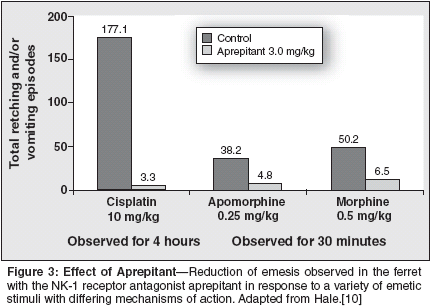
Action Against Delayed Emesis
Serotonin receptor antagonists show a prominent antiemetic effect acutely but do not show an effect in models of delayed emesis. In contrast, preclinical studies of NK-1 receptor antagonists showed that these agents appear to work not only on acute emesis but on delayed emesis as well. This was demonstrated by Grelot and colleagues in a piglet model using the NK-1 receptor antagonist GR205171 following administration of cisplatin.[12] Animals that received the NK-1 receptor antagonist experienced dose-related and statistically significant reductions in both acute and delayed emetic events comparedwith control animals, which received inactive vehicle. A similar experiment assessed acute and delayed cisplatininduced emesis in ferrets given either the NK-1 receptor antagonist aprepitant or inactive vehicle.[13] Aprepitant treatment completely prevented acute emesis in all ferrets treated, and the higher dose (2 mg/kg/d) completely prevented delayed emesis as well, whereas a lower dose (1 mg/kg/d) markedly reduced delayed emesis compared with the inactive vehicle.
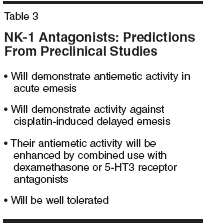
These preclinical studies are important because of the predictions they generated about the likely clinical actions of selective NK-1 receptor antagonists (Table 3),[14-16] which have since largely been borne out in clinical trials (as is discussed in the article by Dr. Grunberg in this supplement). Analyses of several of these trials suggest that serotonin-dependent mechanisms may be most important early in the emetic period, whereas substance P-dependent mechanisms may be more important later, providing a compelling rationale for combination antiemetic therapy.[16]
Pharmacogenomics and CINV
Pharmacogenomics, the study of the relationship between specific DNA sequence variations and the actual effect of a drug, may offer a means tofurther extend and improve our understanding of CINV. As the proportion of patients failing all available antiemetic treatment options continues to diminish, it will be critically important to better characterize which factors differentiate these patients from those with well-controlled emesis. Molecular profiling of malignant tumors and patients' capacities to metabolize drugs has become an increasingly prominent area in oncology in recent years. The same principles could be applied to supportive cancer management as well. There are a number of candidate genes that might have relevance for emesis. As detailed in Table 4, they may be within the serotonergic system, the dopaminergic system, the substance P system, or the cytochrome P-450 (CYP 450) system for drug metabolism. Kaiser and colleagues in Germany have pioneered the application of pharmacogenomics to CINV, and their work has focused primarily on two areas: variations in the metabolism of the serotonin receptor antagonists by CYP 450 genotype, and variations in the 5-HT3 receptor gene itself.
CYP 450 Genotype and Response to Serotonin Receptor Antagonists
The serotonin receptor antagonists are metabolized by CYP 450 enzymes. Specifically, most are predominantly or at least partially metabolized by the CYP 2D6 enzyme. This enzymeis polymorphic, so several different alleles may be present in different individuals. Some of these alleles result in decreased metabolism or no metabolism of drugs metabolized by this pathway. In other cases there may be extra wild-type alleles, which increases metabolism of these drugs. It was therefore hypothesized that individuals with alleles for defective metabolism would not clear the serotonin receptor antagonists and would thus have high blood levels of these drugs. In contrast, individuals with extra wild-type alleles would be expected to have low levels of these drugs because of increased drug clearance.
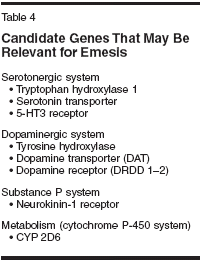
Kaiser and colleagues tested this hypothesis in a clinical trial that correlated CYP 2D6 genotype with the intensity of acute CINV in 270 cancer patients receiving moderately to highly emetogenic chemotherapy; patients received antiemetic therapy with the serotonin receptor antagonists ondansetron (Zofran) or tropisetron.[17] They found a direct correlation between the number of active CYP 2D6 alleles that patients had and the number of vomiting episodes they experienced (Figure 4). Patients with no active alleles do not metabolize serotonin receptor antagonists and therefore have high blood levels of these antiemetic drugs; as expected, these patients had less emesis than did patients with more active alleles. Likewise, some patients had three active wild-type alleles, and these patients had the most vomiting episodes, as would be expected from the fact that they metabolize serotonin receptor antagonists most efficiently and thus have lower blood levels of the drugs. These findings applied both during the first 4 hours after chemotherapy and for hours 5 to 24 following chemotherapy.
5-HT3B Receptor Polymorphisms and Response to Therapy
The same research team has also explored the hypothesis that polymorphisms in the 3B subunit of the5-HT3 receptor may result in differential effects of serotonin receptor antagonists in patients with CINV.[18] They sequenced the 5-HT3B receptor gene among 232 cancer patients treated with ondansetron or tropisetron within the first 24 hours of chemotherapy. Of the 13 polymorphisms identified, one-a deletion of three amino acids (AAG)-appeared to have relevance to antiemetic outcomes. As shown in Figure 5, patients who were homozygous for the deletion of this gene had significantly more episodesof vomiting both acutely and 5 to 24 hours after chemotherapy when compared with patients who had the normal gene present. Although the patients with this polymorphism were a small subgroup of the total sample (1% to 2%), this study nevertheless supports the principle that pharmacogenomics potentially can be used to identify groups that may be at higher risk and who may not respond to conventional therapies.
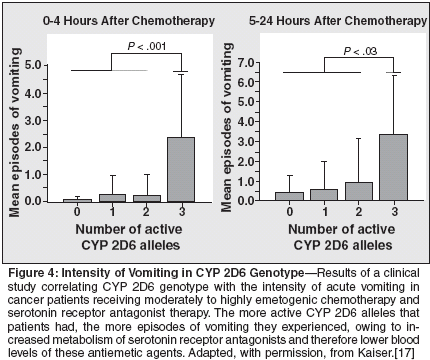

Conclusions
Significant insights into the pathobiology of CINV have been achieved over the past 20 years, providing the basis for improved treatment. This has already been realized with the serotonin receptor antagonists, and our recent understanding of substance P has yielded a useful new class of antiemetics, the selective NK-1 receptor antagonists, that will play an important role in combating acute and especially delayed emesis. Further progress may be achieved through the study of additional neurotransmitter systems and ongoing phamacogenomic research, which may allow more selective targeting of antiemetic treatments.
Disclosures:
Dr. Hesketh receivesgrant/research support from and is a consultantand member of the speakers’ bureau forMerck Research Laboratories, and is a consultantfor GlaxoSmithKline.
References:
1.
Borison HL, Wang SC: Physiology andpharmacology of vomiting. Pharmacol Rev5:193-230, 1953.
2.
Miller AD: Central mechanisms of vomiting.Dig Dis Sci 44(suppl):39S-43S, 1999.
3.
Miner WD, Sanger GJ: Inhibition ofcisplatin-induced vomiting by selective 5-hydroxytryptamineM-receptor antagonism. Br JPharmacol 88:497-499, 1986.
4.
Saria A: The tachykinin NK1 receptor inthe brain: Pharmacology and putative functions.Eur J Pharmacol 375:51-60, 1999.
5.
Carpenter DO, Briggs DB, Strominger N:Peptide-induced emesis in dogs. Behav BrainRes 11:277-281, 1984.
6.
Andrews PLR, Bhandari P: Resinferatoxin,an ultrapotent capsaicin analogue,has anti-emetic properties in the ferret. Neuropharmacology32:799-806, 1993.
7.
Bountra C, Bunce K, Dale T, et al: Antiemeticprofile of a non-peptide neurokinin NK1receptor antagonist, CP-99,994, in ferrets. EurJ Pharmacol 249:R3-R4, 1993.
8.
Tattersall FD, Rycroft W, Hargreaves RJ,et al: The tachykinin NK1 receptor antagonistCP-99,994 attenuates cisplatin induced emesisin the ferret. Eur J Pharmacol 250:R5-R6, 1993.
9.
Watson JW, Gonsalves SF, Fossa AA, etal: The anti-emetic effects of CP-99,994 in theferret and the dog: Role of the NK1 receptor.Br J Pharmacol 115:84-94, 1995.
10.
Hale JJ, Mills SG, MacCoss M, et al:Structural optimization affording 2-(R)-(1-(R)-3, 5-bis(trifluoromethyl)phenylethoxy)-3-(S)-(44-fluoro)phenyl-4-(3-oxo-1,2,4-triazol-5-yl)methylmorpholine, a potent, orally active,long-acting morpholine acetal human NK-1 receptorantagonist. J Med Chem 41:4607-4614,1998.
11.
Tattersall FD, Rycroft W, Francis B, etal: Tachykinin NK1 receptor antagonists actcentrally to inhibit emesis induced by the chemotherapeuticagent cisplatin in ferrets. Neuropharmacology35:1121-1129, 1996.
12.
Grelot L, Dapzol J, Esteve E, et al: Potentinhibition of both the acute and delayedemetic responses to cisplatin in piglets treatedwith GR205171, a novel highly selectivetachykinin NK1 receptor antagonist. Br JPharmacol 124:1643-1650, 1998.
13.
Tattersall FD, Rycroft W, CumberbatchM, et al: The novel NK1 receptor antagonistMK-0869 (L-754,030) and its water solublephosporyl prodrug, L-758,298, inhibit acuteand delayed cisplatin-induced emesis in ferrets.Neuropharmacology 39:652-663, 2000.
14.
Diemunsch P, Grelot L: Potential of substanceP antagonists as antiemetics. Drugs60:533-546, 2000.
15.
Hesketh PJ: Potential role of the NK1receptor antagonists in chemotherapy-inducednausea and vomiting. Support Care Cancer9:350-354, 2001.
16.
Hesketh PJ, Van Belle S, Aapro M, et al:Differential involvement of neurotransmittersthrough the time course of cisplatin-inducedemesis as revealed by therapy with specific receptorantagonists. Eur J Cancer 39:1074-1080, 2003.
17.
Kaiser R, Sezer O, Papies A, et al: Patient-tailored antiemetic treatment with 5-hydroxytryptaminetype 3 receptor antagonistsaccording to cytochrome P-450 2D6 genotypes.J Clin Oncol 20:2805-2811, 2002.
18.
Tremblay PB, Kaiser R, Sezer O, et al:Variations in the 5-hydroxytryptamine type 3Breceptor gene as predictors of the efficacy ofantiemetic treatment in cancer patients. J ClinOncol 21:2147-2155, 2003.
Newsletter
Stay up to date on recent advances in the multidisciplinary approach to cancer.
Oncology Peer Review On-The-Go: Cancer-Related Fatigue Outcome Measures in Integrative Oncology
September 20th 2022Authors Dori Beeler, PhD; Shelley Wang, MD, MPH; and Viraj A. Master, MD, PhD, spoke with CancerNetwork® about a review article on cancer-related fatigue published in the journal ONCOLOGY®.